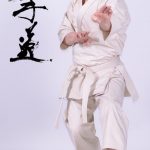
Sanchin-dachi (Hourglass Stance) From Heiko-Dachi stance move one foot forward until the toes of the rear foot are on the same horizontal line as the heel of the front foot and in 30 degrees inward. This powerful stance is used … Continue reading

Sanchin-dachi (Hourglass Stance) From Heiko-Dachi stance move one foot forward until the toes of the rear foot are on the same horizontal line as the heel of the front foot and in 30 degrees inward. This powerful stance is used … Continue reading

Master Mabuni’s motto “Kunshi no Ken” which means to concentrate on cultivating one self to become a well rounded, respectful individual. The person who is able to accomplish this as well as to exercise good manners in all situations with … Continue reading

Itosu no Rohai(鷺牌) Kata Rohai (鷺牌) kata originated from the Tomari-te school of Okinawan martial arts. Master Itosu later took this kata and developed three kata from it: Rohai shodan, Rohai nidan, and Rohai sandan. Itosu Rohai Shodan has different … Continue reading

Shitoryu Karate Kata, Papuren Papuren (八 步 連) Kata Papuren (八 步 連) (also pronounce Happoren or Paipuren means “Eight steps at the same time”) is a kata of karate which was introduced by a White Crane Kung fu expert … Continue reading

Karate (空手); Japanese pronunciation: [kaɾate] is a martial art developed in the Ryukyu Kingdom. It developed from the indigenous Ryukyuan martial arts (called te (手), “hand”; tii in Okinawan) under the influence of Chinese Martial Arts…

Renzoku KihonStart doing Migi Chudan Yoko Uke in Left Moto Dachi, then Shift forward your left foot to Hidari Zenkutsu Dachi and execute Hidari Jodan Maete Zuki, then Shift your left foot back to Hidari Moto Dachido Hidari Chudan Uchi … Continue reading

沖縄空手の「八大要素」= Okinawa karate no 「Hachidai youso」 Meaning : Eight most important elements in Okinawan karate フェーサ 速さ= Feesa – Hayasa Meaning : Speed アティファ 破壊力 = Atifa – HakairyokuMeaning : Destructive force/power チンクチ 締め = Chinkuchi – ShimeMeaning : Tightening チュラサ 美しさ = Churasa – UtsukushisaMeaning … Continue reading

Shitō-ryū is a combination of 4 main karate systems (Shurite, Nahate, Tomarite and Hakkaku Ken “Crane Fist”), which attempts to unite the diverse roots of karate. On one hand, Shitō-ryū has the physical strength and long powerful stances of Shuri-te … Continue reading

Shitoryu Karate Kata, Papuren Papuren (八 步 連) Kata Papuren (八 步 連) (also pronounce Happoren or Paipuren means “Eight steps at the same time”) is a kata of karate which was introduced by a White Crane Kung fu expert … Continue reading

Renzoku Kihon (Combination basic technique),Start by going to Hidari Neko Ashi Dachi executing Chudan Yoko Uke with left arm then shift your front foot forward to Hidari Zenkutsu Dachi and doing Hidari Jodan Zuki followed by doing Migi Chudan Gyaku … Continue reading

60th birthday is called Kanreki (還暦) in Japanese. Kanreki is a starting of a new Cycle of life. This kanji, 還 (kan) means circulate and 暦 (reki) is a calendar and we can understand it as years. So kanreki literary … Continue reading

“Speed & Agility Testing for Karate Kumite Athletes” 空手における組手選手のための速さ&敏捷性測定テスト Experiencing a new concept in Sport Karate スポーツ空手の新しい概念を経験 Designed & Developed By A. Tanzadehアレン ・タンザデ考案 The purpose of designing this Footwork Combination drills is to make a unique way of testing … Continue reading

The New Year has brought another chance for us to set things right and to open up a new chapter in our lives. On the road to success, the rule is always to look ahead. May you reach your destination … Continue reading

A version of sanchin used in Matsumura ha Seisan. This stance is longer than Sanchin-dachi, (one foot longer) but retains the same tension and inward rotation of the knees. It is the basis of the kata Matsumura ha Seisan. Seisan-dachi … Continue reading

(Paralleled-Hourglass Stance)From Heiko Dachi stance with the width of one foot, step one length of a foot forward and make the front foot in 30 degree angle inward while the back foot is in straight line. Basically both length and … Continue reading

(One-Knee Stance or ‘Half Kneeling‘) The width and length of this stance is almost like Moto Dachi. In some positions in different katas, back leg knee may touch the floor also back leg and knee may get closer to the … Continue reading

Kaatsu (加圧, often styled as KAATSU) is a patented exercise method developed by Dr. Yoshiaki Sato that is based on blood flow moderation exercise (or vascular occlusion moderation training) involving compression of the vasculature proximal to the exercising muscles by … Continue reading

Everyone who trains in Shitoryu karate Canada must know the dojo kun. At the end of each training session—whether it be at the dojo, after class, or after a technical Seminar. The dojo kun is repeated all together by the … Continue reading

Soe Ashi-Dachi 添え足立ち (Supported Leg Stance) Both feet are parallel together and back foot is on the toes. Back leg is supporting front leg by touching inner thigh. This stance appears in Papuren Kata.